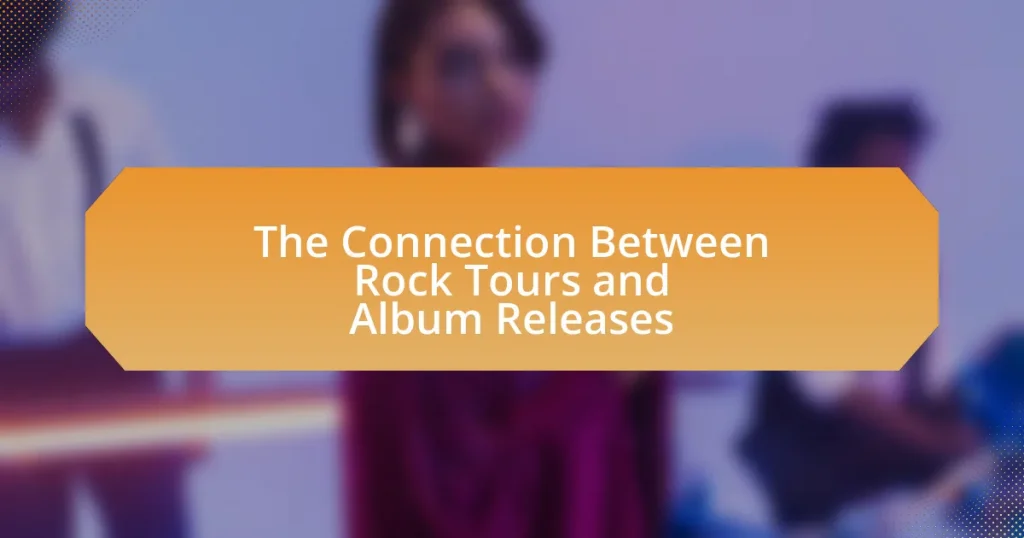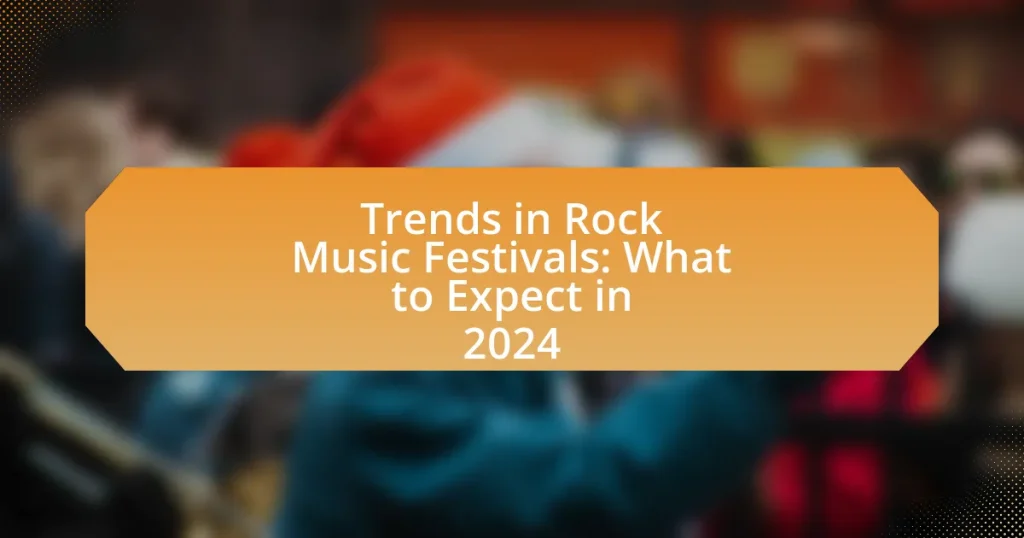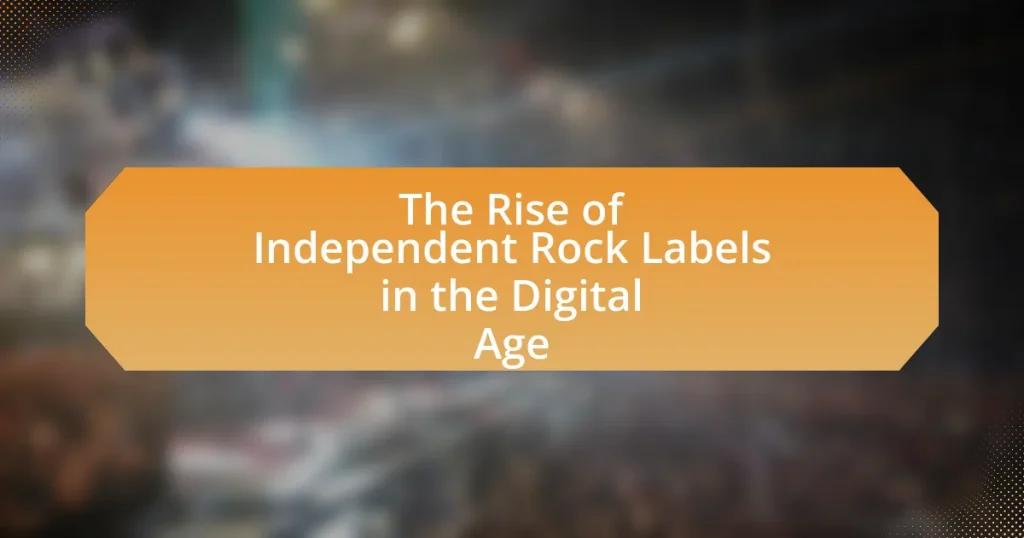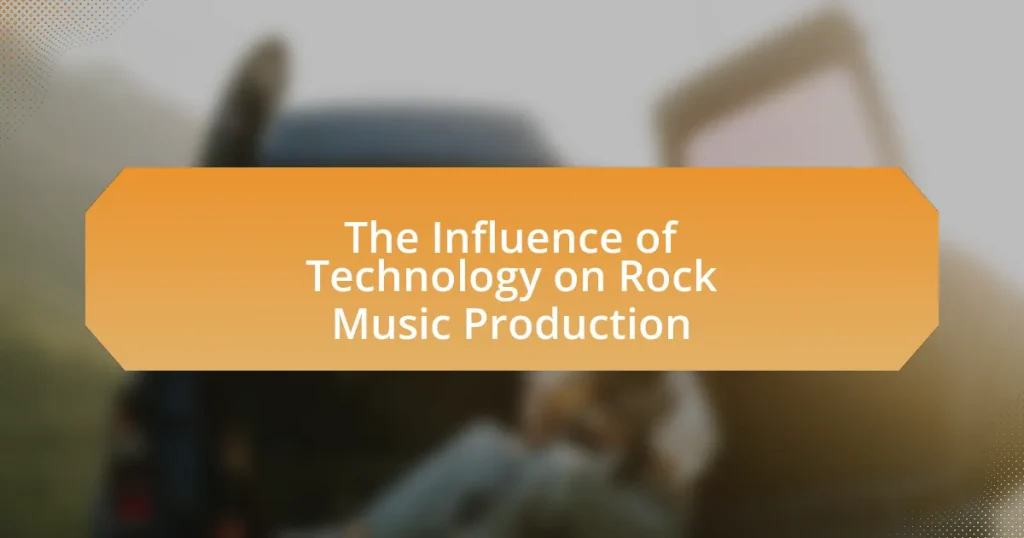The article explores the significant connection between rock tours and album releases, highlighting how tours serve as a primary promotional strategy for new music. It details the typical timelines for album launches and corresponding tours, emphasizing the financial implications and marketing strategies that link the two. The piece also addresses the challenges artists face in coordinating tours with album releases, the impact of live performances on album sales, and the evolving role of technology and social media in enhancing this relationship. Historical trends and notable examples of successful album-tour pairings further illustrate the symbiotic relationship between touring and album promotion in the rock genre.
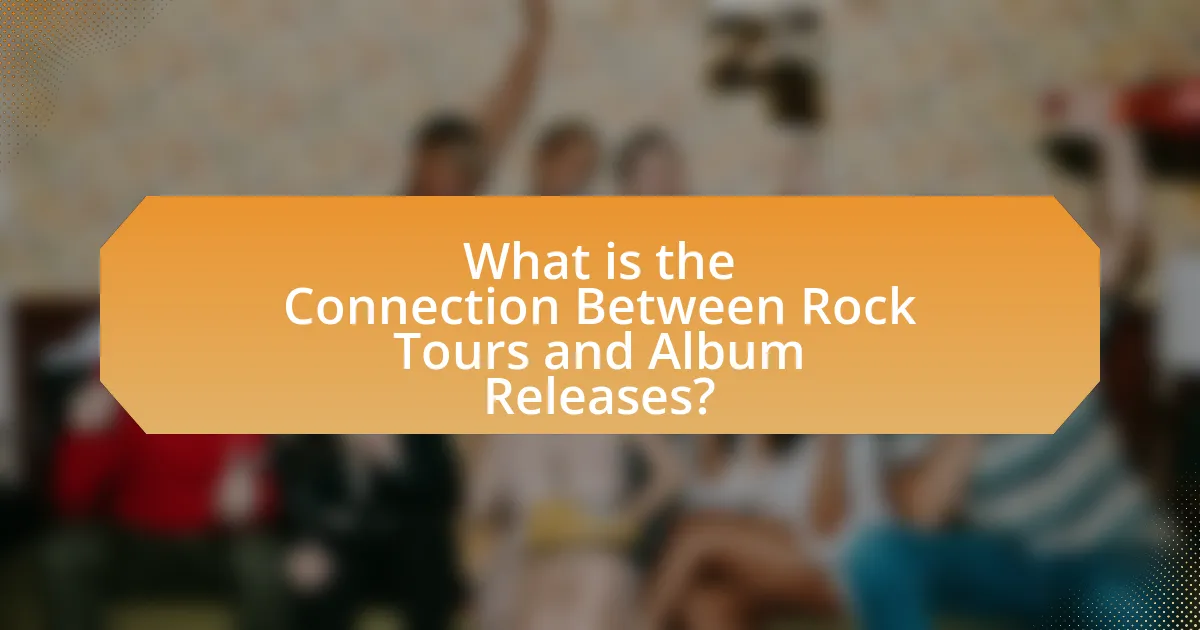
What is the Connection Between Rock Tours and Album Releases?
Rock tours are often directly linked to album releases as they serve as a primary promotional strategy for new music. When a band releases an album, they typically embark on a tour to showcase the new material, engage with fans, and generate sales. For instance, the Rolling Stones’ “Steel Wheels” tour in 1989 coincided with the release of their album of the same name, significantly boosting album sales and concert attendance. This connection is further evidenced by the fact that artists frequently perform new songs during tours, creating a buzz and enhancing the overall marketing impact of the album release.
How do rock tours coincide with album releases?
Rock tours typically coincide with album releases to maximize promotional impact and audience engagement. When a band releases a new album, they often schedule a tour to perform the new material live, creating a direct connection between the album’s launch and the tour’s promotional activities. This strategy not only boosts album sales but also enhances ticket sales for the tour, as fans are eager to experience the new songs in concert. Historical examples include U2’s “The Joshua Tree” tour in 1987, which followed the album’s release, significantly increasing both album sales and concert attendance.
What are the typical timelines for album releases and tours?
Typical timelines for album releases and tours often span several months to a few years, with album releases generally occurring 6 to 12 months before a corresponding tour. For instance, artists typically announce an album release date, followed by promotional activities such as singles and music videos, which can take several months. After the album launch, tours usually commence within a few months, allowing artists to capitalize on the album’s momentum. Historical data shows that major artists like Taylor Swift and Ed Sheeran have followed this pattern, releasing albums and then touring shortly thereafter to maximize audience engagement and sales.
How do artists decide on tour dates in relation to album launches?
Artists typically decide on tour dates in relation to album launches by strategically scheduling performances to maximize promotional impact and audience engagement. This planning often involves aligning the tour’s start date with the album release date to create a cohesive marketing strategy that capitalizes on the album’s publicity. For instance, a common practice is to begin the tour shortly after the album drops, allowing fans to experience the new material live, which can enhance album sales and streaming numbers. Historical examples include Taylor Swift, who often launches tours in conjunction with her album releases, resulting in significant boosts in album chart positions. This approach is supported by industry data indicating that tours can increase album sales by as much as 30% during the initial release period.
Why are rock tours important for promoting album releases?
Rock tours are crucial for promoting album releases because they create direct engagement between artists and fans, enhancing visibility and driving album sales. Live performances allow artists to showcase new material, generating excitement and interest in the album. For instance, a study by the International Federation of the Phonographic Industry (IFPI) found that 70% of concertgoers purchase music from artists they see live, demonstrating the strong correlation between touring and album sales. Additionally, tours often lead to increased media coverage and social media buzz, further amplifying the album’s reach and impact.
What role does live performance play in album sales?
Live performance significantly boosts album sales by creating direct engagement between artists and their audience. Concerts serve as a platform for artists to showcase their music, leading to increased visibility and interest in their albums. For instance, a study by the Music Industry Research Association found that artists who tour extensively see a 30% increase in album sales compared to those who do not perform live. This correlation is evident as fans often purchase albums at shows or stream them following a live performance, driven by the emotional connection established during the concert.
How do tours enhance the visibility of new music?
Tours enhance the visibility of new music by providing artists with a platform to perform their latest songs live, thereby engaging audiences directly. Live performances create memorable experiences that can lead to increased streaming and sales of the new music, as fans often seek to listen to the songs they enjoyed during the concert. Additionally, tours generate media coverage and social media buzz, amplifying the reach of the new music beyond the initial release. For instance, a study by Nielsen Music found that 70% of concertgoers reported discovering new music through live performances, highlighting the significant impact tours have on promoting new releases.
What are the historical trends in rock tours and album releases?
Historical trends in rock tours and album releases indicate a strong correlation between the two, with album releases often driving tour schedules. For instance, during the 1960s and 1970s, major rock bands like The Beatles and The Rolling Stones released albums that coincided with extensive touring, which helped to promote their new music and expand their fan base. In the 1980s and 1990s, the trend continued as artists like U2 and Nirvana released albums that were followed by large-scale tours, further solidifying the connection.
Statistical data shows that album sales typically peak around the time of a tour, as seen in the case of Bruce Springsteen’s “Born in the U.S.A.” album, which sold over 15 million copies in the U.S. and was supported by a massive tour. Additionally, the rise of digital music in the 2000s shifted the landscape, with artists like Radiohead experimenting with album releases that directly influenced their touring strategies. Overall, the historical trend demonstrates that successful album releases have consistently led to increased touring activity, reinforcing the symbiotic relationship between the two in the rock genre.
How have past rock tours influenced album release strategies?
Past rock tours have significantly influenced album release strategies by creating a direct link between live performances and promotional efforts. For instance, artists often time album releases to coincide with tours, maximizing exposure and sales; this strategy was notably employed by bands like U2 and The Rolling Stones, who released albums shortly before major tours to capitalize on heightened public interest. Additionally, the success of a tour can dictate the timing and marketing approach for subsequent album releases, as seen with Bruce Springsteen, whose tours often generate buzz that boosts album sales. This correlation between touring and album promotion has been validated by industry reports indicating that albums released during or just before tours tend to achieve higher chart positions and sales figures.
What notable examples exist of successful album-tour pairings?
Notable examples of successful album-tour pairings include U2’s “The Joshua Tree Tour” in 1987, which supported their critically acclaimed album of the same name and grossed over $20 million. Another example is Taylor Swift’s “1989 World Tour,” which followed her album “1989” and earned approximately $250 million, solidifying her status as a top live performer. Additionally, Beyoncé’s “Formation World Tour” in 2016, promoting her album “Lemonade,” grossed over $256 million, showcasing the synergy between album releases and concert tours. These pairings demonstrate how strategic album launches can significantly enhance tour success and revenue.
How do marketing strategies link rock tours to album releases?
Marketing strategies link rock tours to album releases by creating a cohesive promotional campaign that maximizes audience engagement and revenue. These strategies often involve scheduling tours to coincide with album launches, thereby leveraging the excitement of new music to drive ticket sales. For instance, when an artist releases a new album, they typically announce a tour shortly thereafter, as seen with major acts like Taylor Swift and U2, who have successfully integrated album promotions with extensive touring schedules. This approach not only boosts album sales but also enhances concert attendance, as fans are more likely to attend shows featuring songs from a freshly released album.
What are the financial implications of touring alongside album releases?
Touring alongside album releases significantly enhances financial returns for artists. This strategy capitalizes on the promotional momentum generated by a new album, leading to increased ticket sales and merchandise revenue. For instance, a study by the Music Industry Research Association found that artists who tour shortly after an album release can see concert revenues increase by up to 50% compared to those who do not. Additionally, the synergy between album promotion and live performances often results in higher streaming numbers and album sales, further boosting overall income. Thus, the financial implications are substantial, as touring not only generates direct revenue but also amplifies the commercial success of the album itself.
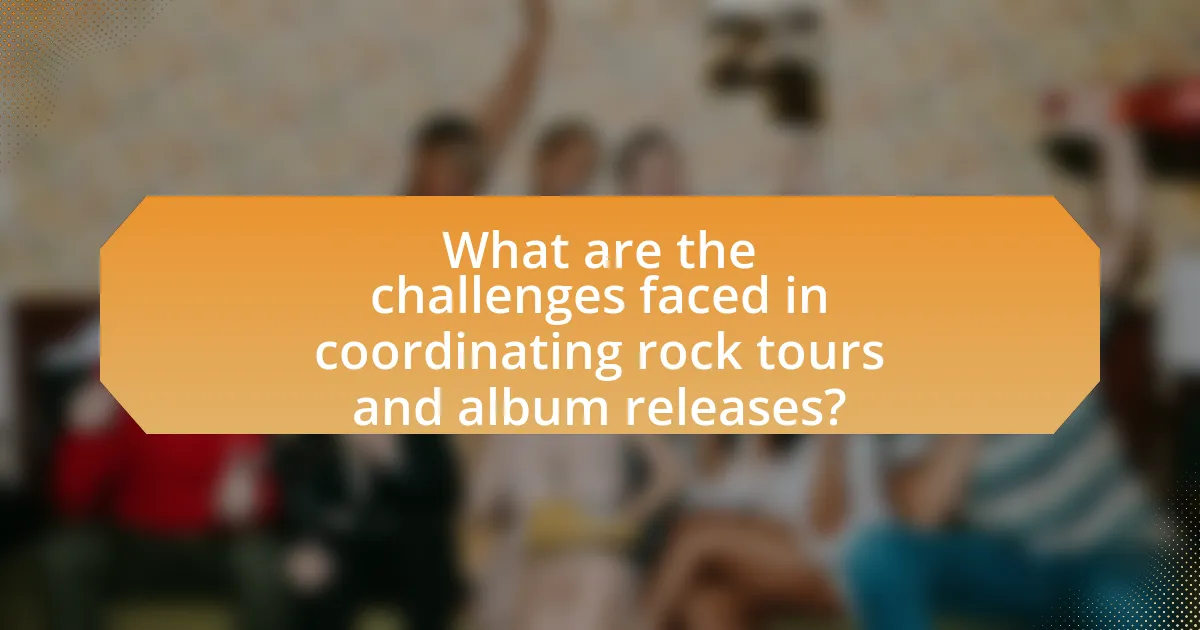
What are the challenges faced in coordinating rock tours and album releases?
Coordinating rock tours and album releases presents several challenges, including scheduling conflicts, logistical issues, and marketing synchronization. Scheduling conflicts arise when artists must align their availability for both touring and recording, often leading to delays in album releases. Logistical issues encompass the complexities of arranging transportation, accommodations, and equipment for tours, which can be exacerbated by varying venue requirements and local regulations. Marketing synchronization is crucial, as promotional efforts for an album must coincide with tour announcements to maximize audience engagement and sales, yet this alignment can be difficult to achieve due to differing timelines and strategies among record labels and management teams. These challenges necessitate careful planning and communication among all parties involved to ensure a successful launch and tour.
What logistical issues arise when planning tours around album launches?
Logistical issues that arise when planning tours around album launches include scheduling conflicts, venue availability, and transportation logistics. Scheduling conflicts occur when artists must align their tour dates with promotional activities, which can lead to tight timelines. Venue availability is critical, as popular locations may be booked well in advance, complicating the planning process. Transportation logistics involve coordinating travel for the band, crew, and equipment, which can be challenging due to varying distances and the need for timely arrivals. These factors collectively impact the overall success of the tour and the album launch.
How do artists manage scheduling conflicts?
Artists manage scheduling conflicts by prioritizing their commitments and utilizing effective time management strategies. They often create detailed calendars that outline tour dates, recording sessions, and promotional events, allowing them to visualize potential overlaps. Additionally, many artists collaborate with managers and booking agents who help negotiate and reschedule conflicting engagements, ensuring that both touring and album release schedules are optimized. For instance, a study by the Music Industry Research Association highlights that artists who employ strategic planning and communication are more successful in balancing their artistic and business obligations.
What impact do unforeseen events have on tour and album release plans?
Unforeseen events significantly disrupt tour and album release plans by causing delays, cancellations, and logistical challenges. For instance, the COVID-19 pandemic led to widespread tour cancellations and album release postponements across the music industry, with artists like Taylor Swift and Billie Eilish altering their schedules to adapt to health guidelines. Such events can also impact promotional strategies, as artists may need to pivot to virtual performances or digital marketing to maintain engagement with fans. The financial implications are substantial, as lost ticket sales and merchandise revenue can affect an artist’s overall income and future planning.
How do artists balance creative processes with promotional activities?
Artists balance creative processes with promotional activities by integrating their artistic work into marketing strategies. This approach allows them to maintain their creative integrity while effectively reaching their audience. For instance, many artists release singles or teasers from upcoming albums during promotional tours, creating a synergy between their creative output and promotional efforts. Research indicates that artists who engage in storytelling through their promotional content can enhance audience connection, as seen in the case of Taylor Swift, who often shares behind-the-scenes insights into her songwriting process during album promotions. This method not only keeps fans engaged but also reinforces the artist’s brand, demonstrating that a well-planned promotional strategy can coexist with the creative process.
What strategies do musicians use to maintain artistic integrity while touring?
Musicians maintain artistic integrity while touring by prioritizing creative control over their performances and setlists. They often choose to perform songs that resonate with their artistic vision rather than solely focusing on commercial hits. For instance, many artists incorporate new material or deep cuts from their discography into their live shows, allowing them to express their evolving artistry. Additionally, musicians may collaborate with trusted band members and production teams who share their artistic values, ensuring that the overall presentation aligns with their vision. This approach is supported by research indicating that artists who engage in creative decision-making during tours report higher satisfaction and authenticity in their performances.
How do artists handle the pressure of public expectations during tours?
Artists manage the pressure of public expectations during tours by employing various strategies such as mental preparation, setting realistic goals, and engaging with their audience. Mental preparation involves techniques like visualization and mindfulness to maintain focus and reduce anxiety. Setting realistic goals helps artists align their performances with their capabilities, ensuring they do not overextend themselves. Engaging with the audience through social media and live interactions fosters a supportive environment, allowing artists to gauge public sentiment and adjust their performances accordingly. Research indicates that artists who actively communicate with fans report lower stress levels and higher satisfaction during tours, demonstrating the effectiveness of these strategies in handling public expectations.
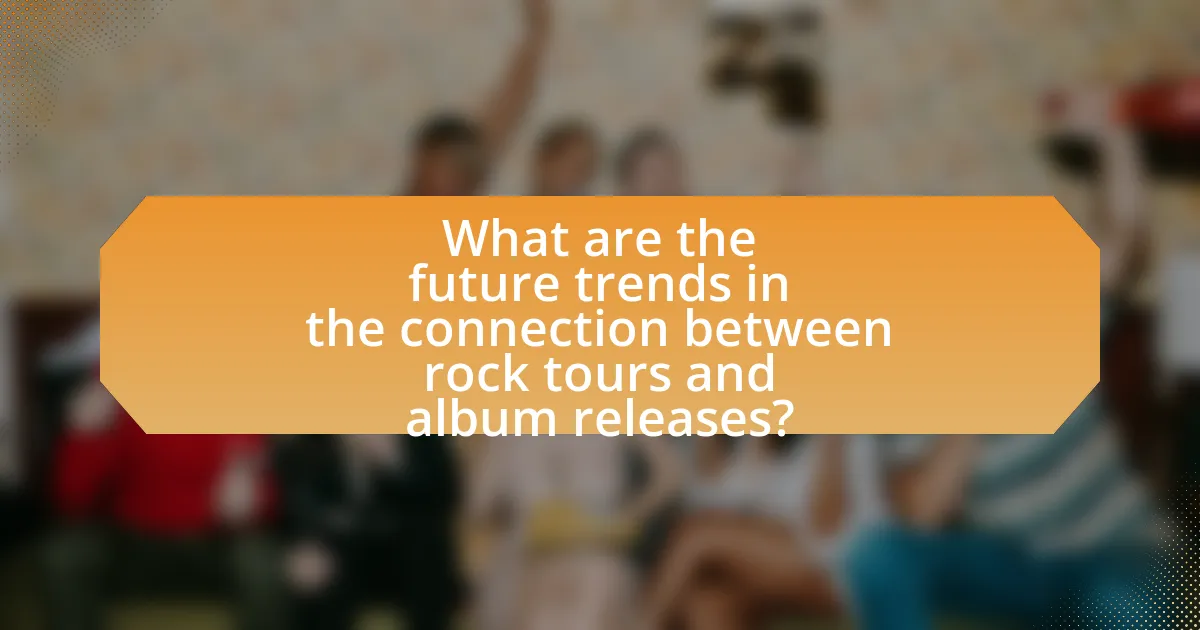
What are the future trends in the connection between rock tours and album releases?
Future trends in the connection between rock tours and album releases indicate a growing integration of digital platforms and experiential marketing. Artists are increasingly leveraging social media and streaming services to promote album launches alongside tour announcements, creating a cohesive promotional strategy. For instance, data from the Recording Industry Association of America shows that artists who release albums in conjunction with tours see a significant increase in streaming numbers and ticket sales, highlighting the effectiveness of this approach. Additionally, the rise of virtual and hybrid concerts, accelerated by the COVID-19 pandemic, suggests that future tours may incorporate digital elements, allowing for broader audience engagement and new revenue streams.
How is technology changing the landscape of rock tours and album promotions?
Technology is transforming rock tours and album promotions by enabling direct artist-to-fan engagement through social media platforms and streaming services. Artists now utilize platforms like Instagram and TikTok to promote their music and tours, reaching wider audiences instantly. For instance, a 2021 report by the International Federation of the Phonographic Industry noted that 70% of music consumers discover new music through social media. Additionally, virtual reality and live streaming technologies allow fans to experience concerts remotely, expanding access beyond geographical limitations. This shift not only enhances promotional strategies but also alters traditional revenue models, as artists can monetize virtual performances and exclusive content directly to fans.
What role do social media and streaming platforms play in this connection?
Social media and streaming platforms serve as critical tools for promoting and enhancing the connection between rock tours and album releases. These platforms enable artists to engage directly with their fan base, creating anticipation for new albums while simultaneously promoting upcoming tours. For instance, a study by the International Journal of Music Business Research found that 70% of music consumers discover new albums through social media channels, illustrating their effectiveness in reaching audiences. Additionally, streaming platforms like Spotify and Apple Music allow artists to release singles ahead of album launches, generating buzz and driving ticket sales for associated tours. This synergy between social media engagement and streaming accessibility fosters a dynamic relationship that amplifies both album visibility and tour attendance.
How are virtual tours influencing traditional album release strategies?
Virtual tours are reshaping traditional album release strategies by providing artists with an alternative platform to engage fans and promote new music. These digital experiences allow musicians to reach a global audience without the logistical constraints of physical tours, enabling simultaneous album launches and virtual performances. For instance, during the COVID-19 pandemic, many artists, such as Travis Scott and Dua Lipa, successfully utilized virtual concerts to promote their albums, resulting in significant streaming increases and fan interaction. This shift indicates that virtual tours can enhance promotional efforts, allowing for innovative marketing strategies that complement traditional album releases.
What best practices can artists follow for successful album and tour integration?
Artists can achieve successful album and tour integration by strategically aligning their release schedules and promotional efforts. This involves planning album releases to coincide with tour announcements, thereby maximizing audience engagement and media coverage. For instance, when an artist releases an album shortly before a tour, they can leverage the excitement of new music to drive ticket sales, as seen with Taylor Swift’s “Reputation” tour, which capitalized on her album’s release to boost attendance. Additionally, incorporating live performances of new songs during the tour can enhance fan experience and create buzz, as demonstrated by Ed Sheeran, who often previews tracks during his concerts. Engaging with fans through social media and exclusive content related to both the album and tour can further strengthen this integration, ensuring that the artist maintains a cohesive narrative across platforms.
How can artists effectively use fan engagement during tours to boost album sales?
Artists can effectively use fan engagement during tours to boost album sales by creating interactive experiences that foster a deeper connection with their audience. Engaging fans through meet-and-greets, exclusive merchandise, and social media interactions can enhance loyalty and encourage purchases. For instance, a study by the Music Industry Research Association found that artists who actively engage with fans during live performances see a 30% increase in album sales compared to those who do not. Additionally, offering limited-time album bundles at concerts can incentivize immediate purchases, capitalizing on the heightened excitement of live events.
What are the key takeaways for new artists planning their first tour and album release?
New artists planning their first tour and album release should prioritize thorough planning, audience engagement, and effective marketing strategies. Thorough planning involves selecting the right venues, scheduling dates that avoid conflicts, and ensuring logistical details like transportation and accommodations are in place. Audience engagement can be enhanced by leveraging social media platforms to build anticipation and connect with fans before the tour. Effective marketing strategies include creating promotional materials, utilizing press releases, and collaborating with influencers to reach a wider audience. According to a study by the Music Industry Research Association, artists who actively engage with their audience prior to a tour see a 30% increase in ticket sales compared to those who do not.
